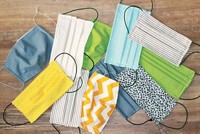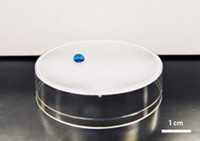Advertisement
Grab your lab coat. Let's get started
Welcome!
Welcome!
Create an account below to get 6 C&EN articles per month, receive newsletters and more - all free.
It seems this is your first time logging in online. Please enter the following information to continue.
As an ACS member you automatically get access to this site. All we need is few more details to create your reading experience.
Not you? Sign in with a different account.
Not you? Sign in with a different account.
ERROR 1
ERROR 1
ERROR 2
ERROR 2
ERROR 2
ERROR 2
ERROR 2
Password and Confirm password must match.
If you have an ACS member number, please enter it here so we can link this account to your membership. (optional)
ERROR 2
ACS values your privacy. By submitting your information, you are gaining access to C&EN and subscribing to our weekly newsletter. We use the information you provide to make your reading experience better, and we will never sell your data to third party members.
Nanomaterials
Covid-19
Nanofibers put a new spin on COVID-19 masks
Start-ups are using nanofibers created by electrospinning to make better face masks
by Fernando Gomollón-Bel, special to C&EN
November 22, 2020
| A version of this story appeared in
Volume 98, Issue 45

When the COVID-19 pandemic struck, 3M announced it would boost global production of N95 face masks to more than 1 billion per year. Mask facilities in China also ramped up, increasing their capacity by nearly 12 times.
With less fanfare, several small companies responded to the pandemic by using nanotechnology to develop what they say is a better kind of mask. Using a fiber production technique called electrospinning, these start-ups have developed nanofibers that capture aerosol dropletsbetter while providing additional breathability. Some of them are manufacturing millions of masks per month. But in the absence of funding to scale up output, their products will likely remain niche offerings, at least during this pandemic.
Electrospinning uses strong electric fields to stretch polymer solutions or droplets into extremely thin fibers, typically between 15 and 300 nm in diameter. Typical N95 masks use polypropylene microfibers, which are orders of magnitude thicker. Most nanofiber masks are also made of polypropylene, but electrospinning allows for additional variety, which is why some manufacturers are looking into greener materials such as cellulose acetate or urethane from renewable carbon.
Support nonprofit science journalism
C&EN has made this story and all of its coverage of the coronavirus epidemic freely available during the outbreak to keep the public informed. To support us:
Donate Join Subscribe
“[Electrospinning] is like making spaghetti but using electricity to help us pull,” says Yi Cui, a professor of materials science at Stanford University and cofounder of 4C Air, a start-up that manufactures air filtration systems based on nanomaterials. The technology is not new. Electrospinning was discovered in the 1930s, and “it has been used to make nanofibers for decades,” Cui says. But the pandemic has created a new market.
4C Air was originally formed to develop a material to tackle air pollution. “Fine particles are extremely dangerous, even more than officially recognized,” says Steven Chu, a cofounder of the firm and a Nobel laureate in physics. Chu and Cui say the firm’s nanomaterials filter these fine particles exceptionally well. And since the aerosol droplets that disperse the novel coronavirus are similar in size, they saw a new opportunity.
“[Electrospinning] is like making spaghetti but using electricity to help us pull.”
—Yi Cui, cofounder, 4C Air
Maryland-based DiPole Materials also specializes in making custom nanofibers. When the pandemic struck the US, the firm redesigned most of its processes. “We soon started working hand in hand with people that needed our help,” DiPole CEO Ken Malone says. “Had it not been for COVID, we probably wouldn’t be in the filter business.”
Nanofibers make good filters mostly because of two factors: mechanical and electrostatic interactions with aerosol particles. Richard L. Corsi, an expert in indoor air quality at Portland State University, compares mechanical filtration to spaceships flying chaotically through a forest.
“It is like those epic battles in Star Wars,” he says. “If there are many trees along the way, the ships are more likely to crash.” And if the trees are disorganized and entangled with branches, they are harder to dodge.
For this reason, nonwoven fabrics—such as those obtained by electrospinning—are more efficient at intercepting small particles. On top of that, nanofibers have higher adsorption surface areas, giving them a greater ability to capture droplets and particles.
The electrostatic charge imparted by electrospinning also plays a role in how nanofibers filter aerosols. “These interactions give the extra boost to remove additional particles,” Corsi says.
Traditional N95 masks also rely partly on electrostatics. They are made with dielectric microfibers that maintain a surface charge for long periods of time, and aerosol droplets stick to them like pieces of paper to a balloon. But Cui argues that this effect is more pronounced with electrospun nanofibers.
“When you go to small particles and small fibers, the [electrostatic] effect begins to play an increasingly important role,” he says. Cui points to independent testing that shows that the firm’s products effectively filter the most penetrating aerosol particles. 4C Air says all its nanofiber masks have been tested by the US National Institute for Occupational Safety and Health and received the N95 certification—meaning they filter at least 95% of airborne particles.
Nanofibers also make masks more comfortable. “They allow more air to pass with the same filtration efficiency,” says Scott R. Gaboury, chief operating officer of DiPole. The main reason for this is physics—specifically, the resistance that the air meets when flowing through the mask, commonly known as pressure drop.
Usually, the higher the filtration efficiency, the higher the pressure drop, which makes the most secure masks, such as N95s, less breathable. However, pressure drop is inversely proportional to the surface area of filter fibers, which is a plus for nanofibers. “We have measured many brands, and usually the pressure drop is over 100 pascals,” Cui says. 4C Air’s masks reduce that resistance by up to 60%. “The breathability is just incredible,” he says.
The Spanish start-up Bioinicia, which also makes masks using electrospinning, has similar claims on its website. Apart from enhanced breathability, its nanofibers dissipate humidity and heat better than traditional fabrics, the firm says. Water droplets created by condensation can dissipate the static charges on the nanofibers and make them less effective filters. Long-lasting charge makes for long-lasting masks, Cui says. “For regular use, you can probably wear our masks for 2 weeks without losing any efficiency,” he says.
Beyond masks, the electrospinning firms are developing other types of protective equipment. 4C Air’s original business is making window screens to filter fine particles, including pollen and pollution.
DiPole Materials is creating a variety of custom-made products for local groups and businesses. Rather than masks, the firm manufactures pieces of fabric that snap into 3-D printed plastic mask frames or can be inserted into cloth masks. It’s working with the University of Maryland Medical Center to develop a specialty mask designed by doctors. And it recently signed an agreement with the US Army to create new nanofiber composites for air filtration.
So far, these companies operate on a small scale, particularly DiPole, which has limited production capacity and has fabricated enough material for only around half a million masks. “Technically, scaling up electrospinning is not difficult, but we prefer to focus on creating specialty products and synthesizing unique nanofibers on demand,” Gaboury says. Although big multibillion-dollar companies have knocked on DiPole’s door, the firm kept filter supply local, he says.
4C Air runs a pilot line in the US and two production lines in China. “We can afford a small production of 2 million masks per month,” Cui says. Bioinicia said in July that it hoped to be making 11 million masks per week by now and expanding beyond Europe. The firm didn’t respond to interview requests.
Big mask makers like 3M have not embraced electrospinning; their established techniques are well entrenched, and investing in new technologies is risky. In terms of air filtration, it’s safe to stick to proven technologies, Corsi points out. “It is amazing how even very simple masks can help us prevent the spread of the virus.”
Executives at electrospun-fiber firms are aware that masks based on their materials will remain niche items during the COVID-19 pandemic. But they are watching a longer time horizon. “This is unlikely to be the last pandemic,” Chu says, and nanofibers could bring masks with “much better protection and much more comfort.”
Fernando Gomollón-Bel is a freelance writer based in Cambridge, England.





Join the conversation
Contact the reporter
Submit a Letter to the Editor for publication
Engage with us on Twitter